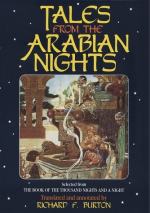As little can we learn from inferences which have been drawn from the body of the book: at most they point to its several editions or redactions. In the Tale of the “Ensorcelled Prince” (vol. i. 77) Mr. Lane (i. 135) conjectured that the four colours of the fishes were suggested by the sumptuary laws of the Mameluke Soldan, Mohammed ibn Kala’un, “subsequently to the commencement of the eighth century of the Flight, or fourteenth of our era.” But he forgets that the same distinction of dress was enforced by the Caliph Omar after the capture of Jerusalem in A.D. 636; that it was revived by Harun al-Rashid, a contemporary of Carolus Magnus and that it was noticed as a long standing grievance by the so-called Mandeville in A.D. 1322. In the Tale of the Porter and the Ladies of Baghdad the “Sultani oranges” (vol. i. 83) have been connected with Sultaniyah city in Persian Irak, which was founded about the middle of the thirteenth century: but “Sultani” may simply mean “royal,” a superior growth. The same story makes mention (vol. i. 94) of Kalandars or religious mendicants, a term popularly corrupted, even in writing, to Karandal.[FN#179] Here again “Kalandar” may be due only to the scribes as the Bresl. Edit. reads Sa’aluk = asker, beggar. The Khan al-Masrur in the Nazarene Broker’s story (i. 265) was a ruin during the early ninth century A.H. = A.D. 1420; but the Bab Zuwaylah (i. 269) dates from A.D. 1087. In the same tale occurs the Darb al-Munkari (or Munakkari) which is probably the Darb al-Munkadi of Al-Makrizi’s careful topography, the Khitat (ii. 40). Here we learn that in his time (about A.D. 1430) the name had become obsolete, and the highway was known as Darb al-Amir Baktamir al-Ustaddar from one of two high officials who both died in the fourteenth century (circ. A.D. 1350). And lastly we have the Khan al-Jawali built about A.D. 1320. In Badr al-Din Hasan (vol. i. 237) “Sahib” is given as a Wazirial title and it dates only from the end of the fourteenth century.[FN#180] In Sindbad the Seaman, there is an allusion (vol. vi. 67) to the great Hindu Kingdom, Vijayanagar of the Narasimha,[FN#181] the great power of the Deccan; but this may be due to editors or scribes as the despotism was founded only in the fourteenth century(A.D. 1320). The Ebony Horse (vol. v. 1) apparently dates before Chaucer; and “The Sleeper and The Waker” (Bresl. Edit. iv. 134-189) may precede Shakespeare’s “Taming of the Shrew”: no stress, however, can be laid




